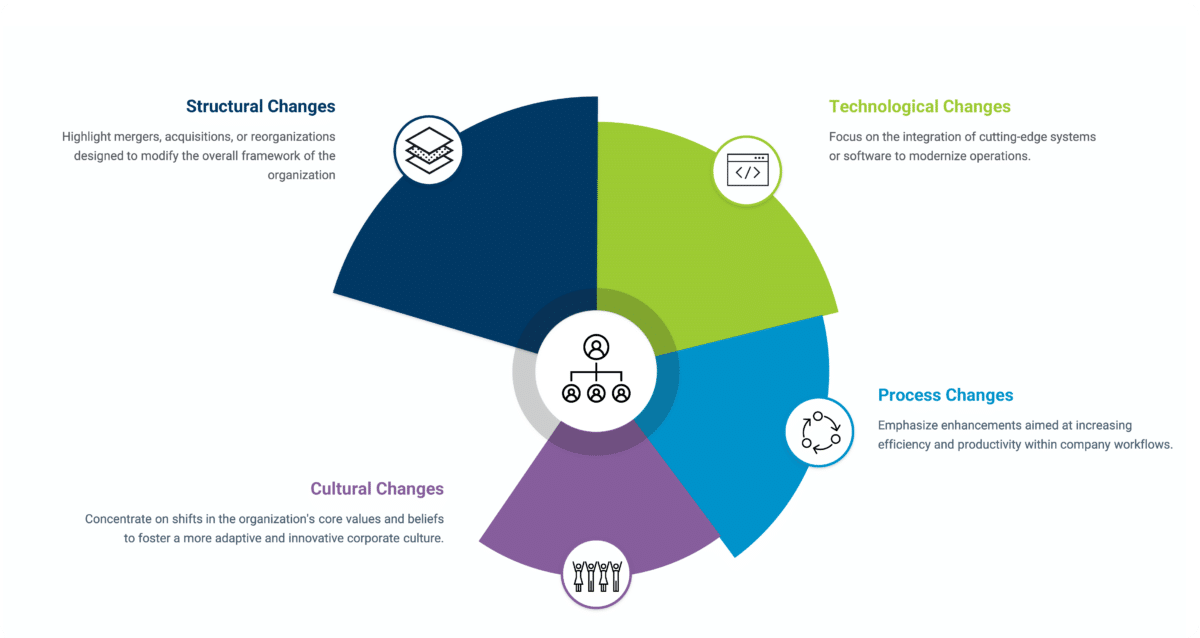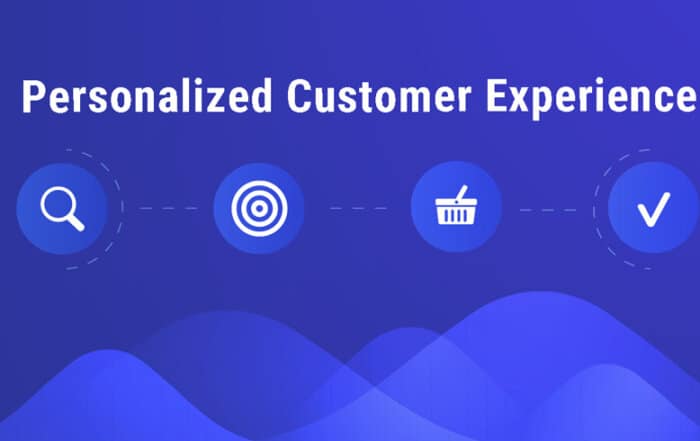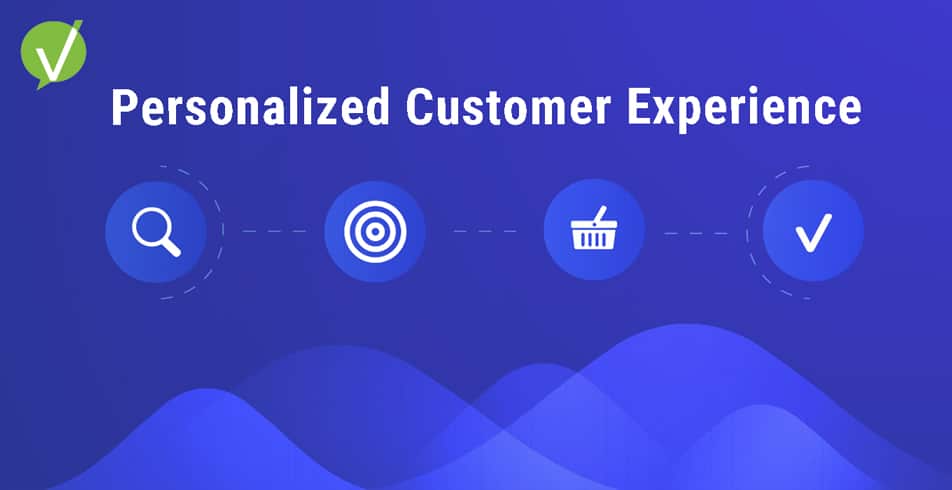Organizational Change Management: A Guide for Modern Leaders
Introduction
As a modern leader, you understand the importance of managing change within your organization to drive growth and success. In this article, we will explore the change management process and provide valuable insights to help you navigate through it effectively.
- Structured Approach: Organizational change management involves a structured approach to address the people side of change. It aims to understand and tackle challenges in implementing new initiatives or modifications to existing processes, ensuring a smooth transition.
- Crucial for Success: Whether introducing new technology, restructuring teams, or changing strategic direction, a change management process is key to initiative success. It minimizes resistance and optimizes adoption, improving productivity and employee satisfaction.
- Guide Contents: This guide covers:
- Different types of organizational change and their importance for growth and adaptation.
- Practical strategies and best practices for effectively managing change.
- The critical role of leadership in navigating individuals through change.
- The significance of clear communication and stakeholder engagement in change management.
So, whether you are a seasoned leader or new to managing change, this guide has something for you. Let’s dive in and discover how you can successfully manage change within your organization!
Understanding Organizational Change and its Impact
Organizational change is an essential process for any company or institution striving for growth and adaptation. In this section, we will explore the different types of change within an organization and delve into the reasons why change is necessary to drive success and innovation.
Types of Organizational Change
When it comes to change within an organization, it can take various forms. These changes can include:
- Structural changes, such as mergers, acquisitions, or reorganizations.
- Technological changes, involving the implementation of new systems or software.
- Process changes, aimed at improving efficiency and productivity.
- Cultural changes, focusing on transforming the organization’s values and beliefs.
Each type of change brings its own set of challenges and opportunities. Successful change implementation requires leaders to understand the specific nature of the change they are undertaking and tailor their approach accordingly.
The Importance of Successful Change Implementation
Implementing change successfully is crucial for organizations to remain competitive and thrive in a rapidly evolving business landscape. Companies that embrace change and can adapt quickly are more likely to seize new opportunities, stay relevant, and achieve long-term success.
However, leaders often face resistance to change within their organizations. This resistance can stem from fear of the unknown, a reluctance to leave familiar routines, or a lack of understanding about the need for change. Overcoming this resistance requires effective communication, stakeholder engagement, and strategic planning.
Overcoming Resistance to Change
Leaders can navigate the challenges of change implementation by taking proactive steps to address resistance. These steps may include:
- Communicating the need for change and the benefits it will bring to individuals and the organization as a whole.
- Engaging employees in the change process by involving them in decision-making and seeking their input.
- Providing training and support to help employees adapt to the change and develop the skills needed for success.
- Celebrating small wins along the way to build momentum and reinforce the positive aspects of the change.
By understanding the types of change within an organization and the challenges associated with change implementation, leaders can navigate the journey towards successful change and drive their initiatives to fruition.
Type of Change |
Challenges |
Opportunities |
|---|---|---|
| Structural | Resistance to new reporting lines; integration of different cultures. | Growth through mergers and acquisitions; improved efficiency. |
| Technological | Resistance to learning new tools; potential disruption of workflows. | Increased productivity; streamlined processes. |
| Process | Resistance to change in routines; fear of decreased job security. | Improved efficiency; reduced waste. |
| Cultural | Resistance to new values and beliefs; potential conflict among employees. | Enhanced collaboration and innovation; alignment with strategic goals. |
Strategies for Effective Organizational Change Management
Organizational change management is critical for leaders who want to drive growth and transformation within their companies. To ensure a successful change management process, it is essential to implement effective change management strategies. By strategically managing organizational change, you can navigate the complexities and challenges that come with transitioning to a new way of operating. Here are some key strategies to help you manage organizational change:
1. Define the Type of Organizational Change
The first step in effective change management is to clearly define the type of organizational change you are implementing. This could include changes in processes, technology, systems, structure, or culture. By understanding the specific type of change, you can better plan and execute the necessary steps to achieve your desired outcomes.
2. Develop a Change Management Plan
A well-defined change management plan is crucial in guiding your organization through the change process. This plan should include the objectives of the change, a timeline, roles and responsibilities, and communication strategies. By having a comprehensive plan in place, you can ensure that everyone is aligned and working towards the same goal.
3. Communicate and Engage with Stakeholders
Open and transparent communication is vital in managing organizational change. Regularly engage with stakeholders at all levels of the organization and communicate the reasons for the change, its benefits, and how it will impact them individually and the organization as a whole. By involving stakeholders in the change process, you can help create a sense of ownership and commitment.
4. Proactively Manage Resistance to Change
Resistance to change is natural, but it can hinder the change management process if not properly addressed. Anticipate and identify potential sources of resistance and develop strategies to address them. Provide coaching and support to individuals and teams as they navigate through the change, offering guidance and resources to alleviate concerns and ensure a smooth transition.
5. Measure and Track Progress
Regularly measure and track the progress of your change management efforts. Set key performance indicators (KPIs) to assess the success of the change and make any necessary adjustments along the way. By monitoring the change process, you can identify areas that require additional attention and take corrective actions to keep the transformation on track.
| Change Management Strategies | Manage Organizational Change | Type of Organizational Change | Steps in the Change Management |
|---|---|---|---|
| 1. Define the type of change | 1. Develop a change management plan | 1. Process change | 1. Define the type of organizational change |
| 2. Develop a change management plan | 2. Communicate and engage with stakeholders | 2. Technology change | 2. Develop a change management plan |
| 3. Communicate and engage with stakeholders | 3. Proactively manage resistance to change | 3. Structural change | 3. Communicate and engage with stakeholders |
| 4. Proactively manage resistance to change | 4. Measure and track progress | 4. Cultural change | 4. Proactively manage resistance to change |
| 5. Measure and track progress | 5. Measure and track progress |
Leading People through Change
When it comes to organizational change, one of the most critical aspects is understanding the people side of change. Change does not happen in isolation; it affects individuals at all levels of the organization. As a leader, it is your responsibility to guide and support your employees through the change process.
Individual change is a deeply personal experience. Each person reacts differently to change, and their emotional response plays a significant role in their ability to adapt and embrace new ways of working. This is why it is essential to develop strong change management skills to navigate these challenges effectively.
Transformational change is not just about implementing new systems or processes; it is about driving meaningful and sustainable change within an organization. To achieve this, leaders must be able to engage and inspire their employees throughout the change journey.
So, how can you effectively lead people through change?
The Role of Empathy and Communication
Empathy is a crucial leadership competency when it comes to managing change. It involves putting yourself in your employees’ shoes and understanding their fears, concerns, and aspirations. By demonstrating empathy, you create a safe space for open and honest communication, fostering trust and collaboration.
Clear and consistent communication is key. It is essential to keep your employees informed and engaged throughout the change process. Provide regular updates, address any concerns or questions, and encourage two-way communication. This ensures that everyone is on the same page and feels supported throughout the transformation.
Implementing Technology for Streamlined Change
Technology systems play a pivotal role in facilitating quick and streamlined changes. They serve as the backbone for effective change management by automating processes, providing real-time data, and ensuring seamless communication across all levels of an organization. By leveraging technology, leaders can swiftly respond to changing scenarios, ensuring that their teams have the tools they need to succeed and adapt with agility.
Creating a Supportive Environment
Leading people through change also means creating a supportive environment where employees feel empowered to adapt and grow. Encourage continuous learning and development, provide resources and training, and celebrate small wins along the way. Recognize and reward individuals who embrace change and contribute to the success of the transformation.
Additionally, the implementation of efficient technology systems is fundamental. These systems support the workforce in navigating change by simplifying complex processes, facilitating better collaboration, and providing a clear view of performance and progress. They enable a quicker response to change, making the transition smoother for all involved.
As a leader, it is crucial to be accessible and approachable. Be open to feedback and actively listen to your employees’ challenges and suggestions. By fostering a culture of trust and support, complemented by robust technology systems, you can cultivate an environment where people feel comfortable embracing change and working towards a common goal.
Guiding Through Uncertainty
Change can be unsettling, and uncertainty is often a natural part of the process. As a leader, it is your responsibility to guide your employees through this uncertainty. Be transparent about the reasoning behind the change and the expected outcomes. Help your team understand how the change aligns with the organization’s vision and values.
Provide clarity by setting clear goals and expectations, and break down the change into manageable steps. This will help alleviate anxiety and enable your employees to focus on the tasks at hand. Technology systems can provide a structured framework for this process, offering a roadmap that can be easily followed and measured for success.
Supporting Individual Growth
Throughout the change process, it is important to recognize and appreciate each individual’s efforts and contributions. Celebrate their achievements and provide support where needed. Offer coaching and mentoring opportunities to help individuals develop new skills and capabilities required for the transformed organization.
By investing in the growth and development of your employees, and by providing them with the technology tools that empower them, you not only support them through the change but also position them for success in the future.
Leading People Through Change – Key Considerations
- Empathy and understanding: Demonstrate empathy, listen actively, and create a safe space for open communication.
- Clear and consistent communication: Provide regular updates, address concerns, and encourage two-way communication.
- Implementing technology for streamlined change: Utilize technology systems for automation, real-time data, and seamless communication.
- Creating a supportive environment: Encourage continuous learning, recognize achievements, and foster a culture of trust and support with the aid of technology.
- Guiding through uncertainty: Be transparent about the change, set clear goals, and provide guidance throughout the process with technological tools.
- Supporting individual growth: Celebrate achievements, offer coaching and mentoring, and invest in employee development through technology-driven programs.
Communication and Stakeholder Engagement
Clear and effective communication is an essential component of successful organizational change management. When navigating change within an organization, you must develop communication strategies that foster a shared understanding of the goals and objectives and engage stakeholders at all levels.
As a leader, it is your responsibility to articulate the side of change you wish to achieve and the reasoning behind it. By providing a clear vision and explaining the benefits, you can create a sense of purpose and inspire trust among your stakeholders. Regularly communicate updates, progress, and challenges to maintain transparency and keep everyone informed throughout the change process.
Crafting clear communication paths and nurturing stakeholder engagement are the cornerstones of effective change management. To seamlessly navigate the tides of organizational transformation, partner with Vivantio to elevate your change management communication strategies. Let’s work together to articulate a compelling vision for change and harness the collective strength of your stakeholders. Schedule a demo today and discover how our communication frameworks can galvanize your team, foster unwavering trust, and propel your organization towards its transformative goals. Engage with our specialists to unlock the potential of stakeholder collaboration and secure a future marked by agile, successful change.













